Mexico’s WWII cañoneros had a very long run after WWII and after the concept had been forgotten elsewhere, stretching past the year 2000.

(ARM Durango during WWII.) (photo from All Hands, the US Navy’s magazine)

(ARM Durango late in the ship’s career, near the turn of the millennium.)
what was a cañonero
Translating to “cannoneer” in English, this was a type of warship which had a brief spurt of popularity before WWII in Iberian and Latin American navies. They were sort of a “jack of all trades”. Besides being basic frigates, they could land a marine detachment, transport small amounts of freight, and be used for training, customs enforcement, disaster relief, and other duties. Cañoneros did not really excel at any of these missions but could still do them all, and overall were an affordable alternative to buying multiple specialized designs. Even by pre-WWII standards they had limited open-ocean combat potential with mediocre guns, little armor, and little or no anti-submarine and anti-aircraft weaponry.
There was no analogy in the US Navy to a cañonero. The closest came during WWII with the US Navy’s APDs, destroyer-escorts adapted to carrying amphibious assault boats. (After WWII Mexico itself would use surplus American APDs, as described later below.) The American and Mexican concepts did not really align, however.
In the British and French navies, the closest relative would have been colonial sloops, but those were made for entirely different reasons.
Basically a cañonero was its own thing.

(Launching of ARM Guanajuato at the SECN shipyard at El Ferrol, Spain on 28 May 1934.)
Mexico placed a five-ship order for cañoneros to Spanish shipyards in late 1932. Two (split between two yards) were of the Durango class, and three (all to SECN) were of the Guanajuato class. Durango, the larger of the two designs, was ordered first but commissioned last.
ARM Durango
Intended as the leadship of a two-hull order, ARM Durango was a larger version of the cañonero concept adding greatly-increased troop and animal accommodation at the expense of buying a larger hull with bigger engines and sacrificing some armament.

(ARM Durango in the baseline pre-WWII configuration during the late 1930s.)
As completed in May 1936, ARM Durango displaced 1,300t standard and 1,950t full. The ship measured 303’2″ x 40′ x 10′ and had a crew of 141. The ship was steam powered, with two Yarrow boilers and two Parsons geared steam turbines delivering 20 kts.
The main guns were two single Mk.LA guns, a Vickers 4″ design license-made in Spain. These were hand-loaded and visually aimed. They fired a 31 lbs shell out to 7 NM maximum range. These guns could only elevate to +30° and had no AA ability.

Above is the breech assembly on a Mk.LA gun. A shell was hand-loaded and the handle moved the horizontal breechblock to the left, where its “teeth” intermeshed with grooves on the gun to form a seal. Above the chamber is a recouperator which put the gun back into battery after being fired.

(The forward Mk.LA mount aboard ARM Durango during WWII.)
The above photo also shows the somewhat odd overall appearance of ARM Durango, with a high freeboard (distance between the waterline and weather deck) and the “boxy” look of much of the superstructure. There were many portholes (windows) and as these ships were not air conditioned, they were usually left open unless the weather dictated – especially in summer with animals aboard. This photo was after the refit in the United States during WWII, with ARM Durango being repainted in US Navy Measure 12 camouflage.
As completed the secondary armament was two open 57mm guns, a Nordenfelt design made under license in Spain. These manually-operated guns had originally been designed in the World War One era as a defense for bigger ships against torpedo boats, but by the 1930s were already obsolete even in that role. However they were cheap and took up little deck space. They were seated abreast of the funnel (smokestack).
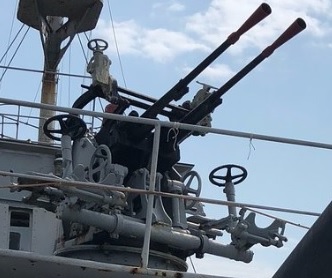
Finally there were two twin Hotchkiss 25mm guns, a French anti-aircraft weapon. These used 15-round box magazines and fired a 25x153mm cartridge at 200rpm. These were joined by two Belgian-designed 13.2mm machine guns.
In contrast to the meager gun armament, ARM Durango‘s spacious transport capabilities were what the Mexicans were more interested in. Much of the below decks space was dedicated to soldiers and pack animals. ARM Durango was designed with berthing for 490 fully-equipped troops and had a stable for 80 horses or mules. The stable was served by a watertight door on the second deck on both sides of the ship.

The stable could be quickly reconfigured to store light artillery or supplies replacing some or all of the animals, or up to 100 extra soldiers.

(Mexican cavalry during WWII. The Mexican army had already started mechanizing before WWII began, a process greatly sped up during the conflict. None the less throughout the 1940s there were still equine units.)
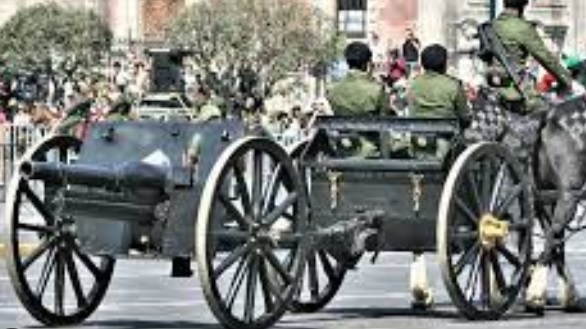
(Animal-drawn field guns were common artillery in the Mexican army until WWII Lend-Lease introduced newer and more powerful American weapons apt to motorized towing.) (photo via Sentinel website)
ARM Durango, like all cañoneros, was not a true amphibious assault ship. It had no ability to beach itself and insufficient boats to land embarked infantry in a single wave. The envisioned tactic was to disembark infantry onto any navigable pier or quay close to the land battle area, and then have them proceed on foot to do battle. In extremis, troops could be put ashore piecemeal with the smallboats carried aboard, but this would take hours and would be unable to concentrate forces for a direct assault.
ARM Durango was classified as “transporte de guerra” (“war transport”) by the Mexican navy in recognition of the enhanced transport abilities compared to the other three cañoneros. In practice it was often still just called a cañonero.
the second ship
The second Durango class ship was to have been ARM Zacatecas. It was ordered from Echavarietta y Larrinaga shipyard in Cadiz, Spain at the same time as ARM Durango was ordered from UN de Levante also in Cadiz. However construction of the second ship did not begin until a month after the first, and lagged behind. ARM Zacatecas was launched on 27 August 1934 but had a protracted fitting out.
In July 1936 ARM Zacatecas was in drydock in Cadiz for final jobs prior to the handover to the Mexican crew. With serious political problems on the horizon, the republican Spanish government seized the ship and ordered it inducted into the Spanish navy as Calvo Sotelo.
The Spanish Civil War, often called the “dress rehearsal of WWII”, began shortly afterwards. Cadiz was overrun by Franco’s nationalists and Calvo Sotelo was completed for the nationalists to a significantly different design than the Mexican plan. It commissioned on 31 May 1938. Calvo Sotelo had a revised “German-style” upperworks and was heavily armed with four 120mm guns, two German 88mm guns, and about a half-dozen smaller weapons.

Calvo Sotelo was used to bottle up the republican destroyer José Luis Díez at Gibraltar. This mission revealed severe problems with Calvo Sotelo caused by alterations to the Mexican plan. The ship was overloaded and the centre-of-gravity had shifted above its danger point. The ship rolled dangerously in bad weather. Two of the four 120mm main guns were deleted to reduce the topweight.
After WWII, during which Spain remained neutral, Calvo Sotelo continued to exhibit stability problems at sea. All the civil war armament was removed and replaced by two 101mm guns and three 20mm AA guns. The ship still performed badly in the open Atlantic and during 1951, Calvo Sotelo was assigned as the mothership for a torpedo boat squadron at Tarifa. Unsuccessful in this role, after 1953 Calvo Sotelo almost never left the pier. It decommissioned in 1957 and was scrapped.
ARM Durango during WWII
Mexico broke relations with Japan after the 7 December 1941 attack on Pearl Harbor, and declared war on Germany, Italy, and Japan on 22 May 1942.
On Mexico’s Caribbean (east) coast, WWII was dominated by German u-boats. This was a type of war that ARM Durango was absolutely unsuitable for in any way.
On Mexico’s Pacific (west) coast, the early part of WWII centered around fears of a Japanese land invasion. Today this might produce an eye-roll of paranoia but it didn’t seem so at the time. If Japan were to attempt some type of direct land action against the USA’s western seaboard, it might make more sense to use Mexico’s Baja peninsula south of Tijuana as a “soft underbelly” beachhead against San Diego as opposed to hammering away at American coastal defenses in California. ARM Durango would be more useful here, in that it could quickly redeploy an infantry battalion to the Baja.
By late summer of 1942, any fears of a Japanese amphibious assault had passed. In the meantime ARM Durango was refitted in the United States. The European anti-aircraft guns were removed and replaced by three American Mk4 20mm AA guns. These were more reliable, had a large snail magazine, and were common to US Navy ammunition supplies.

(WWII American Mk4 20mm gun.) (photo via Rock Island Auctions)
Two bolt-on depth charge racks were added to the stern. ARM Durango had no sonar but this was apparently considered better than nothing if the ship came under Japanese submarine attack.
Even before declaring war, Mexico and the USA had agreed on joint inter-operability naval zones and ARM Durango received new radios compatible with US Navy sets. Finally the ship was cleaned and camouflaged before returning to Mexico.
For the rest of WWII ARM Durango had uneventful service.
after WWII
WWII ended in September 1945. At that time, ARM Durango was only nine years old. It had been an expensive investment and was going to remain in service.
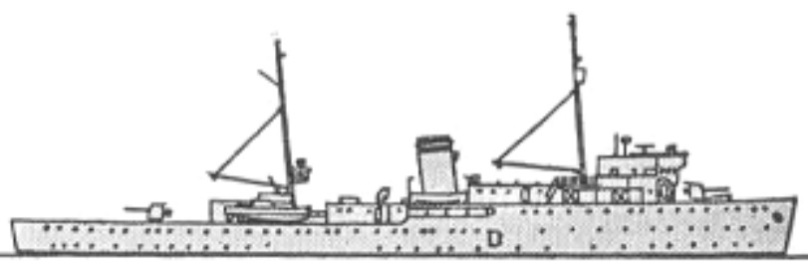
(ARM Durango in post-WWII configuration.) (artwork via navypedia website)
The depth charges were removed as being useless on a ship of this type. However overall, Mexico still viewed ARM Durango as a valuable asset. By the start of the 1950s, it remained an effective way of moving soldiers from point A to point B.
Mexico also had need for open-ocean ships to patrol, whatever their main intended function. For the second half of the 20th century the Mexican navy was in a unique situation: The northern sea frontier sat opposite an infinitely stronger navy of a stable government, to the point there was little sense strategizing any defense of it. However the southern sea frontier, on both coasts, sat opposite navies much weaker than Mexico’s but with unstable parent governments.
These concerns mixed with a relatively new post-WWII concept, that being extension of national waters and the creation of “maritime economic areas” outside them, which would eventually coalesce into the EEZ (exclusive economic zone) concept in the late 1970s. EEZs are regions of the sea which, while remaining international waters, have fishing, oil, and other rights dominated by or reserved to a specific country. They can extend up to 200 miles from the coast whereas national waters only extend 12.

(A Guatemalan P-51 Mustang overflies a Mexican fishing trawler during December 1958. Incursions of Mexican trawlers into Guatemalan waters led to the sinking of two boats by P-51s.)
One example of this kind of dispute is illustrated above. Guatemala accused (and was later proven right) Mexican fishing trawlers of encroaching on their sea areas. After two trawlers were sunk by Guatemala’s WWII-vintage P-51 Mustangs during 1958, the two nations nearly went to war in 1959. Bridges on the border were blown by the Guatemalan army to slow the expected Mexican invasion, meanwhile the Mexican air force drew up a war plan for a preemptive strike to destroy Guatemala’s air force on the ground. In the end, diplomacy resolved the situation.
For situations like these, ARM Durango was still a useful asset. Patrols at sea could hopefully avert the creation of a crisis while the troop-carrying ability would be of use if things turned into war.
major refit
During 1967 ARM Durango underwent a major refit and modification. The entire steam propulsion plant (boilers, geared steam turbines, condensators, etc) was ripped out and replaced by two 8-cylinder Enterprise DMR-38 diesels. The two diesel engines were hard-linked to generators in turn wired to large electric motors, which then turned the existing two propeller shafts.

(Enterprise built diesels for the US Navy during WWII and also made ashore diesel-generator kits. The company was acquired by Delaval and later Transamerica. It ceased production during the 1970s. Today Cooper Machinery Services provides limited support for the few Enterprise diesels still in use.)
The new set-up offered a variety of advantages. The engine room became less cramped with no need for steam lines, reserve feedwater tanks, etc. The ship could “cold start” in a matter of minutes as opposed to the two hours or more needed for lighting off boilers and building a head of steam. It was much easier to manage fuel consumption, as the diesels could generally be run at set RPM ranges with varying voltage to the motors then making speed adjustments. The pre-WWII boilers were by then 30 years old and at the end of their lives anyways, and the new American diesels were an economic alternative to replacing them.
The maximum speed fell by two knots to 18 kts which was considered of little importance. The funnel (smokestack) topside was replaced by a modern type.

(ARM Durango after the refit.)
The third deck’s (closest to the waterline) portholes were plated over to improve damage control in the event of flooding. The two WWII pole masts were replaced by modern light alloy tripod masts. Radar was installed for the first time. Electronics to use the US Navy’s LORAN radio-navigation system were installed.
The features for transporting animals were eliminated as the Mexican military had become fully motorized. This greatly improved the comfort level for transported troops and allowed the ship to accommodate midshipmen or trainee petty officer ratings as well. The smallboat handling space was rearranged and increased however ARM Durango was still not a true amphibious assault ship.
One additional American 20mm mount was fitted but otherwise the weaponry remained unchanged. By the end of the 1960s the pre-WWII Vickers guns had little practical battle value however this kept the cost of the refit down.
The refit was not simple nor without risk. Completely altering the engine room layout required significant planning. However it was done well and the refit was a success.

(ARM Durango in Sydney, Australia during 1969.)
later career
Mexico still had faith in the cañonero concept, however, not in the form of the refit ARM Durango. Two years after WWII, in 1947, the Mexican navy began to import surplus WWII-veteran warships from the United States; a process which continued into the 1980s. Starting in the 1960s the first WWII APDs (destroyer-escort hulls modified to carry landing craft) were received.

(ARM Coahuila had been USS Barber (APD-57) during WWII. This Charles Lawrence class APD had put men ashore at Okinawa. It served Mexico until 2001.)
As described later below these filled the niche of the cañonero.

(ARM Durango during the early 1970s.)
ARM Durango made an unusual mission during 1968, carrying the lit torch for the 1968 Summer Olympics in Mexico City. ARM Durango embarked the torch in the Bahamas and transported it across the Caribbean. ARM Durango anchored several hundred yards offshore of Veracruz and a chain of Mexico’s best swimmers relayed it to the beach, holding it above the water as they swam.

(The captain of ARM Durango, Cpt. Tomás Ortego Bertrand, transferring the Olympic flame to the first of the relay swimmers.)
During 1970 ARM Durango visited Ghana, the first visit by a Mexican warship to a newly-independent African nation.
In the mid-1970s ARM Durango was used sporadically as a training ship, with trainees using the troop accommodations. This was a success.
During the late 1970s, the continuing stream of WWII-era warships being provided by the USA led to consideration of retiring ARM Durango, even though the refit had only been done 10 years previous. For a while the ship was laid up inactive. However it was still in good condition and the decision was made to retain it in service. From 1982 onwards, it was used exclusively as a training ship.

(ARM Durango during 1982.)
The Mexican navy has high shipboard standards and despite being half a century old by the 1990s, ARM Durango was still in remarkably good condition. None the less it was obsolete in anything but a basic training role.

(ARM Durango on the other side of the pier to ARM Quetzalcóatl during January 1995. The Gearing class destroyer had been USS Vogelgesang (DD-862) during WWII. By this time ARM Durango’s radar fit had been upgraded to the same as ARM Guanajuato, described later below.)
ARM Durango decommissioned in 2001 after 65 years in service, having made 2,093 voyages.
the Guanajuato class
ARM Guanajuato, ARM Querétaro, and ARM Potosi were true cañoneros as opposed to ARM Durango which was an adaptation of the concept more oriented towards transport. All three were built by SECN in Spain.

(Builder’s plaque aboard ARM Guanajuato.)
As completed these ships measured 254′ x 38′ x 13′ and displaced 1,350t standard and 1,900t full; with a crew of 140. They had an identical powerplant to ARM Durango but with less powerful engines needed to move the smaller hull at the same 20 kts speed.

(ARM Potosi in the original baseline configuration.)
The main armament was three 4″ Mk.LA guns, the same type as aboard ARM Durango, but with three mounts instead of two.
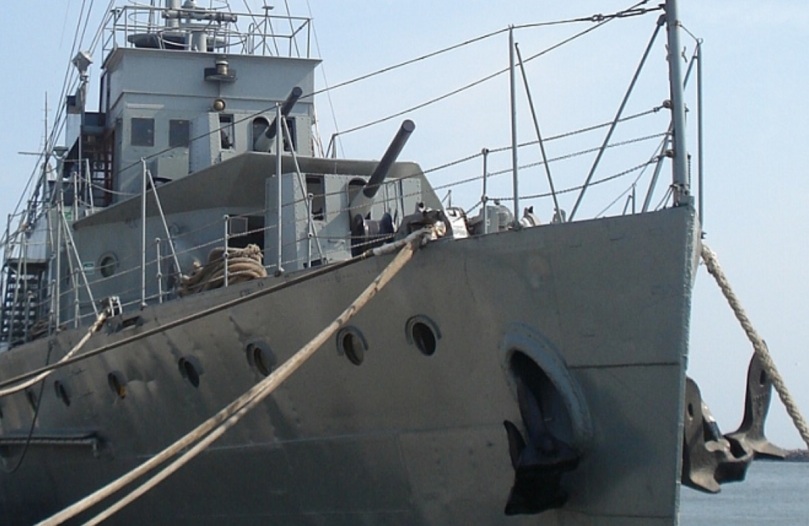
(The steel “lip” underneath the upper forward 4″ gun shielded the guncrew of the lower weapon from the gun’s concussion, as the turrets were open to the rear. The T-shaped device atop the bridge was the optical rangefinder for the main battery. As completed, the class had no radar.)

(The Royal Navy at that time still used inch measurements. When the 4″ Vickers gun design was license-built in metric Spain, it was designated a 101.6mm weapon. As with the Durango class, these guns aboard the Guanajuato class had no AA ability.)
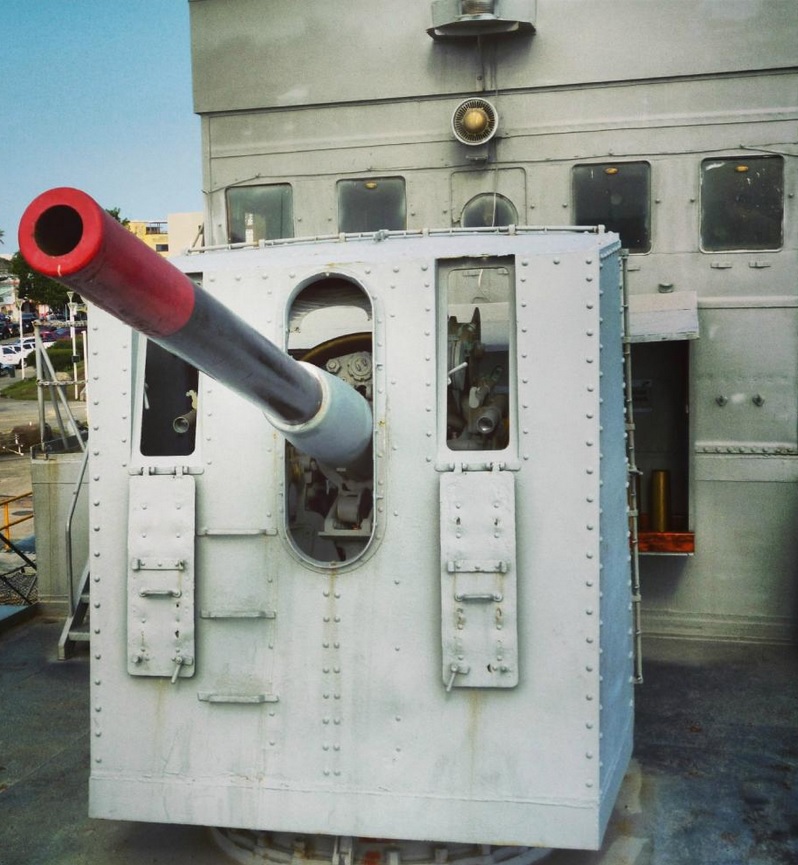
(The “turrets”, which were open in the rear, were basically elaborate gunshields which protected the guncrew from weather and shrapnel. They offered little armor protection against direct fire. On-mount sights were fitted as seen. As with several other navies worldwide, the Mexican navy sometimes painted the barrels red as a way of positively observing where the muzzle was pointed, as the hand-operated gun had no safety interlock.)
The secondary armament was two twin Hotchkiss 25mm AA guns, the same type as carried aboard ARM Durango, and pintles for mounting two machine guns.

(Hotchkiss AA guns aboard ARM Guanajuato.)
With the exception of the nearly useless 57mm weapons, the Guanajuato class carried the same secondary armament as the bigger Durango design on a less expensive hull, plus with the addition of a third 4″ main gun.

(ARM Guanajuato in the late 1930s, just prior to the start of WWII.)
The tradeoff was that the Guanajuato design had less transport ability than ARM Durango. Only 230 troops, or 40 animals, or a mixture thereof; could be transported at a time. The accommodations (especially with mules or horses aboard) were less ideal than the Durango layout and loading and unloading was more cumbersome and time-consuming. None the less the Guanajuato design successfully filled the cañonero role.

(Helm, compass, repeater, and engine order telegraph arrangement on ARM Guanajuato.)
during WWII
The Guanajuato class became important even before Mexico formally entered WWII in 1942.
With the war’s start in Europe in 1939, there was a strong desire in Mexico to stay neutral. This became more complicated after Germany overran France and the Low Countries during 1940. Now the Caribbean Sea was a complex body of water. Out of Bermuda, the Bahamas, Jamaica, and British Honduras (today Belize) were operating active British and Canadian warships. Meanwhile France’s forces in Martinique and Guadeloupe initially adhered to the Axis-puppet Vichy regime whereas the Netherlands Antilles, their colonial power occupied at home, remained on the Allied side. The American and Dominican Republic navies were at sea, each protecting their neutrality. Mexico’s neighbor Guatemala was under the control of Jorge Ubico, a flunky of the USA’s United Fruit Company but also allegedly an admirer of Hitler and Mussolini.
The Mexican navy previously used obsolete turn-of-the-century warships or yacht-type vessels for midshipman cruises. Now in 1940, this was judged too dangerous. Instead, ARM Querétaro was tasked with the 1940 training cruise. The troop accommodations were used for midshipmen of the Mexican Naval Academy and also seniors of a military high school; the two voyages being combined. In this role ARM Querétaro made the 1940 cruise in abbreviated form, starting in Veracruz and arcing north towards the USA and then down to Mexico’s Yucatan peninsula.
During the first part of 1941, with German u-boats now active in the Caribbean, these three ships were used for coastal neutrality patrols.
As mentioned earlier Mexico entered WWII in May 1942. All three ships were sent to the United States for a refit. Similarly to ARM Durango, all the European AA guns were removed. They were replaced by US Navy-standard models, two Mk4 20mm and two Mk3 40mm. The main 4″ armament was left unchanged. Depth charge racks were added to the stern. A radio direction-finder and new communications gear was installed.

(The Mk3 40mm single mounting selected for this class was less common than the Mk2 twin or Mk4 quad usually seen on American WWII warships.)

(ARM Querétaro in WWII form with depth charge racks installed.) (photo from All Hands, the US Navy’s magazine)
In the Caribbean Sea, the cañoneros were used to escort Allied convoys. On Mexico’s other coast, they were used for training and to undertake general patrol missions in the far eastern Pacific.

(A WWII-era identification drawing of the class.)
after WWII
Mexico judged these cañoneros as a success during WWII and they were desired for retention. This in itself is somewhat noteworthy, as Mexico’s navy had a huge turnover with a massive influx of WWII-surplus US Navy vessels starting in 1947, replacing just about the whole fleet.
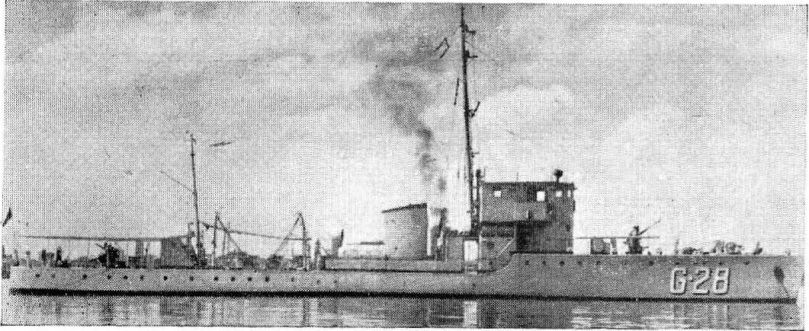
As an example, Mexico bought eight 184t cutters from Spanish shipyards at the same time as the cañoneros. They had German-made diesels and French-made guns, and were lightly armored. By 1959 (only 14 years after WWII), ARM G-28 pictured above was not only the last of these cutters remaining, but other than the cañoneros the last remaining “no de los norteamericanos” (not from the USA) warship in the entire navy. ARM G-28 itself only served on as it had been “americanized” with General Motors diesels and WWII US Navy weapons.

(ARM Potosi’s appearance after WWII.) (line drawing via navypedia website)
The three Guanajuato class ships remained in unaltered WWII form, including the anti-submarine ordnance. The transport side of the cañonero concept was now less important. By the 1950s pack animals were only a memory and totally unmechanized infantry was fading away itself.

(Marmon-Harrington CTVL tankettes of the Mexican army during WWII. During and after WWII, American-supplied M8 Greyhound armored cars replaced them. The Guanajuato class cañoneros could not carry combat vehicles, which were obviously now key items in land warfare.)
The USA began supplying large WWII tank landing ships (LSTs) to Mexico in 1971. These could directly land armored fighting vehicles, which the pre-WWII cañoneros could not handle at all.
major refit
Similar to ARM Durango described above, these three cañoneros were given major refits: ARM Querétaro in 1958, ARM Potosi in 1961, and ARM Guanajuato in 1964.
Like their larger cousin, the entire steam-based propulsion system was completely ripped out and replaced by the same kind of Enterprise diesel engines.

(Starboard DMR-38 engine aboard ARM Guanajuato.)
The propulsion conversion was especially successful in this class, as it freed up a lot of extra room. Combined with the deletion of any lingering features related to carrying animals, this made troop accommodations much less cramped. The medical facilities aboard were improved.
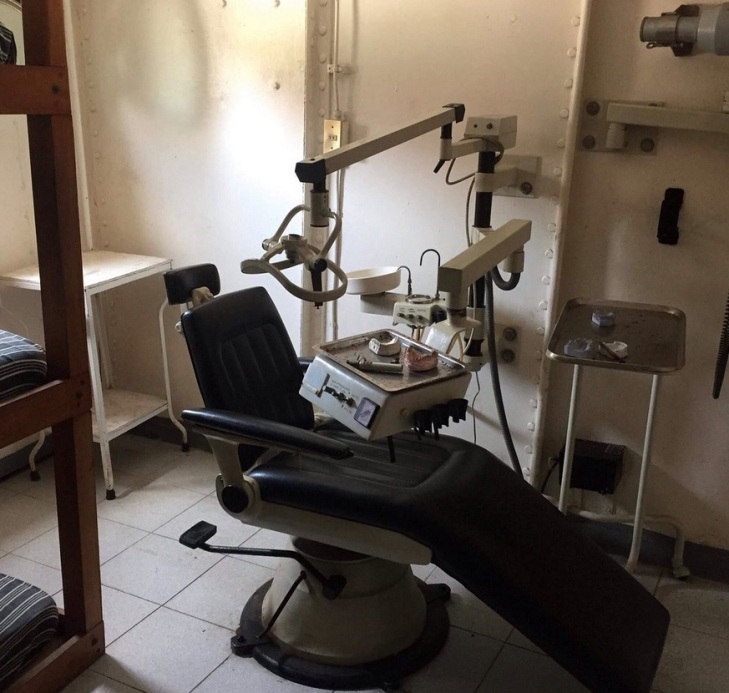
(Dental chair in ARM Guanajuato’s sick bay.)
The WWII depth charge racks were deleted, but otherwise the armament was left unchanged. Radar was installed, as was equipment to use the American LORAN radio-navigation system. The large WWII searchlight was removed.
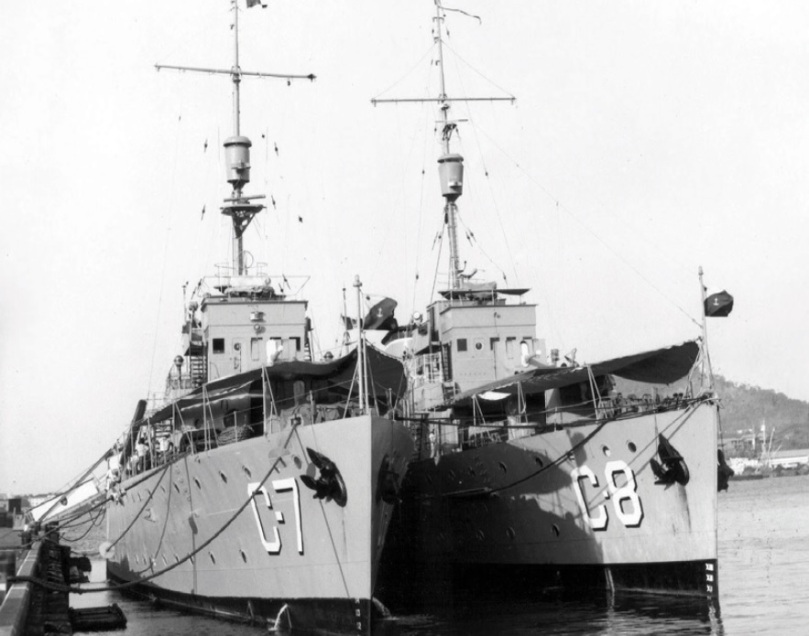
(ARM Guanajuato and ARM Querétaro after being refit.)

(Curiously, the 1930s crow’s nest was never removed off these three ships, even after they received radars.)
later careers
In the Cold War-era Mexican fleet, the role of the cañonero was usurped by WWII APDs transferred from the United States. These ships, based on destroyer-escort hulls, had a 5″ main gun, better AA weaponry, and were designed from the start with sonar and radar. Like the original pre-WWII cañonero concept, they were fully-capable patrol ships. But most importantly, their embarked LCVPs allowed them to directly put men ashore over the beach.

(ARM Tehuantupec had been USS Joseph M. Auman (APD-117) during WWII. It was transferred to Mexico in 1963 and served until 1989.) (photo via navsource website)
Still, the three cañoneros were useful assets for normal patrol duty and niche missions where the ability to carry passengers was useful.

(ARM Potosi with a tug alongside. The Mexican navy changed its hull numbering sequence several times between the end of WWII and the late 1990s. The three cañoneros were originally not numbered at all, then in the C-_ sequence, then a two-digit numbers only sequence, then a H_ sequence as seen above, then the C-_ system again.)

(ARM Querétaro with the numbers only system.)

(ARM Guanajuato with the final C-_ sequence it would wear for the rest of its career. This was in 1968 during a visit to Kiel, West Germany.)
As they were highly seaworthy ships with good range on the new diesels, the three cañoneros made good choices for peacetime deployments abroad. During 1964, ARM Querétaro and ARM Potosi sailed a grand voyage that visited France, Italy, the USA, Yugoslavia, Malta, Egypt, and Portugal. Four years later, ARM Guanajuato toured ports in West Germany and Scandanavia.
During 1975 all three ships were laid up inactive. After some deliberation, it was decided to scrap ARM Querétaro and ARM Potosi. ARM Guanajuato was in the best condition of the three ships and was reactivated.

(ARM Guanajuato late in the ship’s career.)
The British company Kelvin Hughes revamped ARM Guanajuato‘s electronics. A Type 17 surface search radar and Type 14 navigation radar were installed. These compact, modern radars replaced antique WWII radars on numerous Mexican warships after the United States stopped supporting them with spare parts during the late 1970s and 1980s. The Kelvin Hughes setup was thus common to much of the Mexican fleet which made ARM Guanajuato more valuable in the training role. A new fathometer and modern navigation plot were installed.
Some consideration was given to replacing the obsolete 4″ main guns. The Mexicans determined that the proposed replacement, WWII-era American Mk21 3″ guns, would offer little additional combat potential and this idea was nixed to keep the costs down.
ARM Guanajuato rejoining the fleet was welcomed as even in peacetime, the Mexican navy had a lot on its plate. The earlier-mentioned EEZ control mission only intensified during the 1970s. Organized “gangs” of foreign fisheries poachers were a problem. At the same time the growing offshore oil industry in the Gulf Of Mexico required attention.
In the early 1980s, a new menace emerged, one which would eventually harm all of Mexican society by the 2000s: drug smuggling. Contrary to “Miami Vice”-type scenarios with flashy speedboats, most of this was done by trawlers, shrimp boats, and small freighters. They were not fast and it didn’t require a speedy destroyer or frigate to chase them down. But it did require a lot of ships constantly at sea to find them. Many of Mexico’s WWII-era American-made vessels were repurposed for this new problem.

(ARM Valentin Gómez Farias during 2015. During WWII this ship had been USS Starling (MSF-64), an Auk class minesweeper. For the “narcopatrol” mission, the Mexicans deleted all the minesweeping equipment and built a small helipad over the aft deck.)
While ARM Guanajuato itself was not normally tasked with “narcopatrol”, its continued availability freed up other ships for the task.
ARM Guanajuato‘s main role was training. By the 1990s it certainly stood out on the world stage in this regard with elaborate 1930s woodwork in the interior; a look largely absent from warships after the huge increase in the lethality of naval weapons during and after WWII.

(Stained-glass door on ARM Guanajuato’s ship’s library.)
In 1975 it had only been intended to keep ARM Guanajuato in the training role on an interim basis, but it was economical and successful in the role so the ship served on and on. Mexico continued to make piecemeal upgrades to it, including a digital VHF marine-band radio and a GPS receiver.
At the same time the ship, now well past double its intended lifespan, was beginning to show its age. The 1997-1998 edition of Jane’s Fighting Ships stated that the maximum speed had fallen to 14 kts. The ship’s last long-distance training voyages came in 1997, thereafter it was only used in Mexican waters or nearby.
In the early summer of 2001, ARM Guanajuato was relieved in the fleet training role by ARM Commodore Manuel Azueta. This ship had been USS Hurst (DE-250) during WWII.

(ARM Commodore Manuel Azueta, a WWII Edsall class destroyer-escort, served as the designated training ship until 2016 and was then sunk as an artificial reef.)
In July 2001, ARM Guanajuato decommissioned after 65 years and 2 months of service.

(ARM Guanajuato’s appearance as decommissioned.)
final fates
After decommissioning in 2001, ARM Durango spent about a year and a half in unmaintained reserve. On 9 May 2003, Mexico’s secretary of the navy transferred the decommissioned ship to the governor of Sinaloa state, with the goal of it being refurbished and opened as a museum or tourist attraction.
The ship was given to the Integral Port Authority of Mazatlán and docked at Mazatlán’s merchant ship #4 pier. Unfortunately here the plan fell apart. No agreement could be made as to where, or in what form, the ship would be permanently moored. As months of disagreements turned into years, the now 70-year old hull started to deteriorate. During 2009 the ex-ARM Durango was repossessed by the Sinaloa state government and scrapped.
As mentioned earlier ARM Querétaro and ARM Potosi were already scrapped in 1975.
After ARM Guanajuato decommissioned during the summer of 2001, Mexico’s then-president Vincente Fox ordered the ship preserved as an interactive museum of the Mexican navy. It was towed to Boca del Río near Veracruz and moored at a specially-made dock on the Jamapa River, next to the popular Banderas Square. The titular owner of the ship was the Veracruz Aquarium Trusteeship.

(ARM Guanajuato shortly after opening as a museum ship in Boca del Río.)
The museum as opened was very well done. The curators attempted to restore some of the ship’s original look, including removing the American weapons and one of the modern radars, and reinstalling two of the old Hotchkiss AA guns which, quite remarkably, had been in storage since being removed from this class during WWII. The tour guides were highly knowledgeable and the ship was kept in pristine condition. Much of the equipment (sirens, navigational gear, etc) still functioned and could be operated for visitors.
Like many museum ships worldwide, it was expensive to keep maintained. Several years after opening, an enclosed restaurant was built atop the aft superstructure. While this took away from the historical authenticity of the cañonero’s appearance, it brought a fresh influx of money to the project. Into the 2010s ARM Guanajuato looked to be a model for running a WWII museum ship.
Problems started in the late 2010s. A repaving project of the adjacent square lowered foot traffic in the area and the onboard restaurant went out of business. From 2017 onwards the ship was open only sporadically, and then not at all. During 2018 the hull was found to be in much worse condition than feared, with severe rust at and just below the waterline. During 2019, a plan was put forth to rejuvenate the museum ship during 2020. Two long-term options were studied. One was to build a concrete base under the keel. This would not stop future rusting altogether, but would prevent the ship from sinking. The other was to physically remove the ship out of the river which would be more expensive, probably prohibitively.
Unfortunately during the spring of 2020 travel and public gathering restrictions within Mexico completely ended all tourism in Veracruz for a year, and also resulted in zero upkeep being done on the ship in 2020. The trusteeship in charge of the project became defunct and the museum ship’s title reverted to the city of Boca del Río. By the end of 2020 ARM Guanajuato was in very poor condition, yet the city still was studying plans to somehow save the ship heading into 2021.

(This is actually the port side of the ship, facing the river, during the winter of 2020 – 2021. The Jamapa River carries a lot of silt and flotsam which went unattended. By 2022 there was so much silt that a person could walk on it like dry land. This side of the ship also weathered worse than the starboard side facing the pier. This photo also shows the closed restaurant atop the aft superstructure.)
By 2022 ARM Guanajuato was clearly in extremely bad condition. Aft, the second deck’s portholes were underwater and one could only believe that the ship had flooded out internally. Forward near the bow, there were several baseball-sized holes where rust had completely eaten through the hull.

(The stern transom in late 2021. The second deck’s portholes are underwater and based on the rust and grime pattern, the first deck’s were sometimes at the waterline. The bow end of the ship was trimmed up over 1′, presumably due to the aft end being flooded out inside.)
During 2022 a remarkable announcement was made, in that an effort was underway to salvage as many artifacts aboard installed when ARM Guanajuato was made a museum ship. Following that, it was said that the 86-year old hull would be “…disassembled in sections, repaired, and then returned.”. The statement was met with incredulity by anybody familiar with warships.

(Starboard side of ARM Guanajuato during November 2022.)
On 29 November 2022 the mayor of Boca del Río announced that ARM Guanajuato would be scrapped. During December 2022, an order was given to speed up the normal two-month bidding process as the hulk was further deteriorating. Scrapping of the world’s last cañonero began in early December.
There should be no “blame” as for over a decade, the project managed to maintain an excellent museum ship. In any nation, a museum WWII warship is much different than say a tank or fighter plane, which can be restored and then displayed with little additional investment. A museum ship is a “financial zombie”, requiring continuous money to stay afloat. Every passing year makes the job tougher as the hull continues to slowly rust. This can be seen in the USA with the ongoing struggles to save the museum ships USS Olympia (IX-40) and USS Texas (BB-35), and the failed 2022 effort to save the WWII submarine USS Clagmore (SS-243). In the latter case, emergency repairs would have cost the museum $9 million and deterioration would have resumed as soon as it hit the water again. At a certain point, it just ceases to be possible.
Had it not been for the 2020 events perhaps ARM Guanajuato might have been saved, or perhaps it was just too old anyways.
the cañonero legacy
Mexico’s navy retired the classification “cañonero” as archaic along with ARM Guanajuato.
In the modern Mexican fleet however there are two ships which have traces of this concept. ARM Huasteco and ARM Zapoteco, both built in 1986, are lightly-armed with just one 40mm gun but have a helipad the WWII cañoneros lacked.



I found this most interesting even if ships are not my main interest.
LikeLiked by 1 person
thank you
LikeLike
Canonero, YAH!!
canyaneeeerroooooooooo
LikeLike
I’m glad I’m not the only one who remembers that Simpsons episode lol
LikeLike
Great post as ever – fascinating to see the history of those, and also get a picture of Mexico’s wider fleet.
I actually did a couple of trips on one of the ex-Auk’s (I think P113) in 2004 out into the Pacific. Great stuff, even if I did spend 4 days being sick …
LikeLiked by 1 person
Those animal pens must have smelled terrible in that area of the ship. Thanks.
LikeLiked by 1 person
when I was writing this, I kept thinking the same thing
LikeLike
As always, interesting and informative.
LikeLiked by 1 person
Nice summary of the problem with “museum ships” – when they exit service they are in a decent state of repair and local government entities are happy to get them since it will be an attraction and all they need is a pier.
Then add a few decades and the hull is rusting and the thing is going to sink at its mooring. Here in South Carolina we are glad to be able to keep the USS Yorktown and USS Laffey, both WW2 combat veterans, in decent shape. The USS Clamagore sub was only launched at the very end of the war and was reconfigured in the 1960’s to look nothing like it did during WW2. So, we’re saying goodbye to that.
At one point in time, we had a retired nuclear powered cruise ship (the NS Savannah) here which was not of much interest. That was from 81-94.
LikeLiked by 1 person
Thank you for yet another informative article on a little known subject.
I find it an interesting concept for a ship – I suspect it would have been quite useful in some of Mexico’s earlier rebellions, able to support small forces anywhere near the coast.
LikeLiked by 1 person